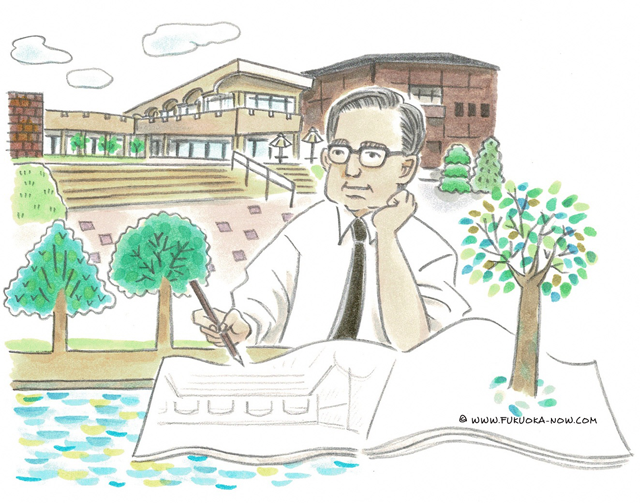Hakata Culture vol.146
Kunio Maekawa and the Fukuoka Art Museum

The Fukuoka Art Museum reopened on Mar. 21 after extensive renovations lasting two-and-a-half years. Aiming to create a more open facility, a new entrance was built on the Ohori Park side of the museum and the cafe and restaurant were upgraded. In addition to building and facility renovations, more galleries that citizens can use were added along with a play area for kids.
The Fukuoka Art Museum, which first opened in November 1979, was designed by Kunio Maekawa, a highly skilled architect who worked on many public buildings and art museums in particular. With brick tiles that stand out in contrast to the greenery of the park, the museum’s exterior design is striking, but these tiles were not merely veneers pressed on the concrete walls with an adhesive; rather, Maekawa developed customized tiles embedded in concrete. This technique not only provides for aesthetically pleasing surfaces, but it is also more durable.
After graduating from the Tokyo Imperial University (now the University of Tokyo), Maekawa traveled to Paris to study modern architecture under the famed French architect Le Corbusier. Upon his return, he worked for Antonin Raymond's architecture firm in Tokyo before striking out on his own. He remained a leading figure in the architecture world for many years and helped Japanese architecture catch up to the West. He left behind an extensive body of outstanding work and also trained the next generation of Japanese architects. He designed more than 200 buildings throughout Japan and remained active until he passed away in 1986 at the age of 81.
The new and improved Fukuoka Art Museum has kept Maekawa’s design elements, including the tiled walls, arched ceilings, and the esplanade (second-floor outdoor patio) intact along with the original light fixtures and furniture. On the other hand, it has been updated to accommodate universal design and take the environment into consideration with LED lighting and other measures.
Here’s hoping the museum will remain a favorite gathering spot for the residents of Fukuoka for many years to come, all while carrying on the legacy of Kunio Maekawa.
建築家・前川國男と福岡市美術館
2年半にわたる大規模改修を終えて、3月21日にリニューアルオープンした福岡市美術館。「より開かれた美術館」を目指して、大濠公園側に新しいエントランスを設け、カフェやレストランも充実させました。建物や設備をリニューアルしただけでなく、市民が利用できるギャラリーを増やしたり、子どもが遊べるキッズスペースを設けるなど、さまざまな工夫があります。
1979年11月に開館した福岡市美術館は、多くの公共建築物を手がけ、とりわけ美術館建築にすぐれた作品を残した建築家・前川國男が設計しました。公園の緑に映えるレンガ色のタイルが印象的ですが、単純にコンクリートの壁にタイルを貼っているのではなく、コンクリートと一体化して建設する打ち込みタイル工法がとられています。この工法によって、美しさと同時に頑丈さも実現しているのです。
前川國男は東京帝国大学を卒業後、パリへ渡り、近代建築の祖とされるル・コルビジェに学びました。帰国後は東京のアントニン・レーモンドの事務所で働き、その後独立します。欧米に比べて遅れていた日本の建築界で、近代建築の第一人者として長く活躍し、多くの優秀な建築家も育てています。日本全国で200を超える作品を設計し、1986年に81歳で亡くなるまで現役の建築家として活躍しました。
新しくなった福岡市美術館では、タイルの外壁、アーチ型の天井、2階の屋外広場「エスプラナード」など、前川建築の特徴がそのまま残され、照明器具や家具なども開館当時のものです。その一方でユニバーサルデザインに対応し、LED照明を使用するなど環境にも配慮しています。前川建築の良さを受け継ぎ、これからも長く市民に親しまれるスポットになっていくでしょう。

